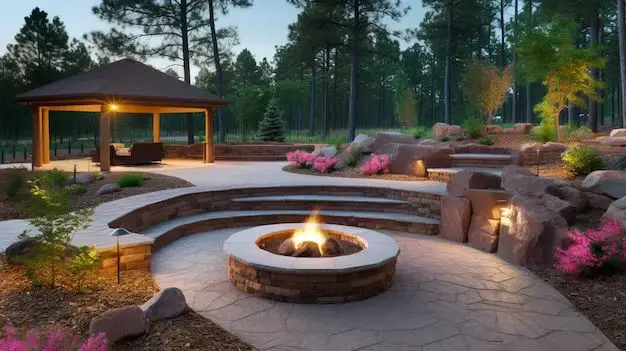Putting a fire pit in a gazebo is possible, but there are some important safety considerations to keep in mind. Here is a quick overview of what you need to know about installing a fire pit in a gazebo:
Page Contents
Fire Safety
Fire pits can get extremely hot, so it’s crucial that the gazebo is made from non-flammable materials. Wood, straw and fabric gazebos would be major fire hazards. Choose a gazebo made from brick, stone, concrete, metal, or other non-combustible materials.
There should be at least 5-10 feet of clearance between the fire pit and the gazebo walls. Sparks can fly out of the fire pit, so you don’t want the walls too close. Make sure there are no trees, shrubs, furniture, etc. within the hot zone around the fire pit.
Have a fire extinguisher on hand whenever the fire pit is lit. An ABC extinguisher designed for common combustibles like wood, paper and cloth is ideal. Train everyone in the household on proper use of the extinguisher.
Avoid using accelerants like gasoline or kerosene to light the fire, as they can cause dangerous flare-ups. Use kindling and newspaper instead.
Extinguish the fire completely before leaving the gazebo. Scrape back the logs to uncover any hot coals and douse them with water.
Ventilation
Fire pits release smoke, carbon monoxide and other byproducts of combustion. In an enclosed space like a gazebo, ventilation is very important to prevent hazardous buildup of gases.
The gazebo should have large screened openings at the top to allow hot air, smoke and carbon monoxide to escape. Cross-ventilation (openings on opposite sides) is ideal for good air circulation.
Never use a gazebo with vinyl or other solid siding that can trap gases inside. There must be adequate ventilation openings.
Only use fire pits designed for outdoor/open-air settings. Do not use indoor-only fireplaces or pits, as they are not made for sufficient ventilation.
Permits and Regulations
Many areas require permits and inspection of outdoor fire pits. Check with your local fire marshal’s office for requirements.
There are often rules about acceptable times of day for fire pit use in residential areas. Be considerate of neighbors regarding smoke drift.
Some homeowners insurance policies prohibit or restrict outdoor fires. Check with your insurance provider to make sure putting a fire pit in your gazebo will not violate policy terms.
Gazebo Construction
The gazebo must be safely constructed to handle the additional weight and forces of a fire pit:
- Reinforced foundation to support fire pit weight
- Extra bracing on walls to resist lateral forces
- Heat-resistant roof (metal, tile, etc. – no standard shingles)
- Fireproof and properly sealed decking materials
Work with a qualified contractor experienced in building outdoor structures for fire features. Do not compromise on structural safety.
Fire Pit Selection
Choose an outdoor-rated fire pit or fireplace specifically designed for use on decks and patios:
- Heavy duty steel or masonry construction
- Tall sides to contain sparks
- Mesh screen lid for safety when not in use
- Good air flow to support combustion
- Raised design to protect decking underneath
A permanent masonry fireplace with a chimney offers the best safety and heat containment. But pre-fabricated fire pits are often more affordable and can work well if properly installed.
Conclusion
With careful planning and adherence to fire codes, installing a fire pit in your gazebo can provide hours of warmth and enjoyment. Be sure to select fireproof, well-ventilated gazebo materials and leave plenty of clearance around the pit itself. With safety as the priority, a gazebo fire pit can give you an inviting outdoor room to extend your living space.
